Air ram is not only a weapon of Soviet heroes
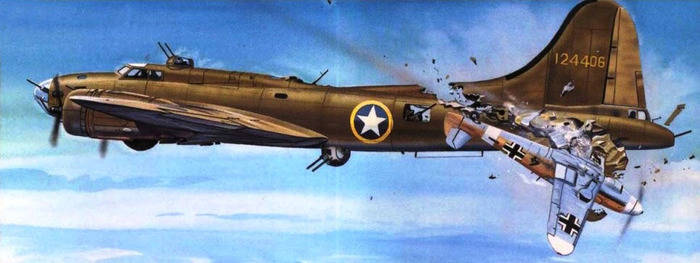
This post is the result of my long-standing collaboration with the Samara historian Alexei Stepanov, who owned the idea of this topic. We worked on the topic at the turn of the 80-90s, but then youth, youthful maximalism and lack of information did not allow us to complete the study with serious scientific work. Now, for more than 20 years, a lot of new information has opened up, but the intensity of passions has faded. Therefore, this article lost the then indignantly revealing pathos addressed to the Soviet historical “Pseudo-science”, but significantly replenished with specific information. In addition, today I have absolutely no desire to engage in scientific activity and create a serious, but boring scientific work, speckled with difficult reading links to sources. Therefore, I present to everyone interested a simple journalistic article about the heroes of air rams, who were not lucky to be born in the USSR, and therefore they lost the right to respect for their bravery among Russian people, who generally always valued courage and heroism. I warn you right away, since a lot has been written about Soviet rams, I will only talk about foreign "rammers", mentioning our only if they are superior - "not for the sake of humiliation, but for justice ..."
For a long time, Soviet official historical science, using the example of air rams, emphasized the special patriotic heroism of Soviet pilots, unattainable for representatives of other nations. In our literature in Soviet times, only domestic and Japanese air rams were always mentioned; moreover, if the rams of Soviet pilots seemed our propaganda to be heroic, conscious self-sacrifice, then the very same actions of the Japanese for some reason were called "fanaticism" and "doom." Thus, all Soviet pilots who committed a suicide attack were surrounded by a halo of heroes, and Japanese pilots, “kamikaze,” were surrounded by a halo of “antiheroes.” Representatives of other countries, in the heroism of the air ramming by Soviet researchers, were generally denied. This prejudice persisted until the collapse of the Soviet Union, and the legacy of many years of silencing the heroism of the pilots of other countries is still felt. “It is deeply symbolic that there wasn’t a single pilot in the praised Hitler’s Luftwaffe who consciously went into an air ram at a critical moment ... There is also no evidence of the use of the ram by American and English pilots,” he wrote in a special work in 1989 about rams major general aviation A.D. Zaitsev. “During the war, such a truly Russian, Soviet form of air combat as a ram was spread,” says the capital work on the history of Russian aviation, “The Air Force of the Motherland,” published in 1988. “An air ram is a standard of military feat. The diametrically opposite attitude to the ram was the first moral defeat of the vaunted Hitler aces, a harbinger of our victory ”- this is the opinion of the best Soviet ace of the Great Patriotic War, Ivan Kozhedub, expressed by him in 1990 (by the way, Kozhedub himself did not commit any rams). There are a lot of examples of such a nationalist approach to this problem. Soviet aviation history experts either did not know, or deliberately lied and hushed up data on rams committed by foreign pilots, although it was enough to refer to the memoirs of Soviet pilots or to foreign works on the history of aviation to make sure that ramming is a wider phenomenon, what seemed to our historians. Against the background of this attitude to history, there was no longer surprising confusion in Russian literature on such issues as: who made the second and third aerial rams in the world, who rammed the enemy for the first time at night, who made the first ground ram (the so-called “Gastello feat”), etc. etc. Today, information about the heroes of other countries has become available, and all people who are interested in the history of aviation have the opportunity to turn to the appropriate books to find out about their exploits. I publish this post for those who are new to aviation history, but would like to learn something about respectable people.
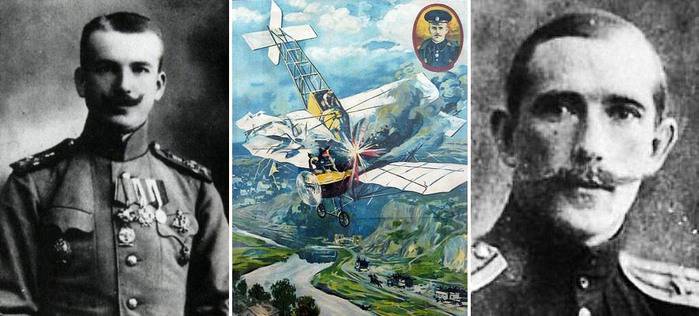
It is well known that our compatriot Peter Nesterov, who destroyed 8 September 1914 g at the cost of his life the Austrian reconnaissance aircraft "Albatross", made the first air ram in the world. But the honor of the second ram in the world for a long time was attributed to N. Zherdev, who fought in 1938 in Spain, then A. Gubenko, who fought in China that same year. And only after the collapse of the Soviet Union in our literature appeared information about the real hero of the second air ram - Russian pilot of the 1 World War II Alexander Kozakov, who 18 of March 1915 r over the front line was hit by an Austrian Albatross with a ram attack. Moreover, Kozakov became the first pilot to survive a suicide strike on an enemy plane: on the damaged Moran, he managed to make a successful landing in the disposition of Russian troops. The long silence of Kozakov's achievement was due to the fact that later this most productive Russian ace of the 1 World War I (32 of victory) became a White Guard and fought against Soviet power. Such a hero, naturally, did not suit Soviet historians, and his name was removed from the history of Russian aviation for many decades, it turned out to be simply forgotten ...
However, even taking into account the hostility of Soviet historians to the White Guard Kozakov, they did not have the right to confer the title of "rammer No. 2" to either Zherdev or Gubenko, since even during 1 World War I several foreign pilots also made air rambles. For example, in September, 1916 F, flying on the DH2 fighter, captain of the British Aviation Eiselwood hit the German Albatross with a strike of the chassis of his fighter, and then landed "on the belly" at his airfield. In June, Canadian William Bishop 1917 r, having shot all the cartridges in battle, deliberately severed the wing racks of the German Albatross with a wing of his Newpora. The wings of the enemy from the impact folded, and the German fell to the ground; Bishop also safely reached the airfield. Subsequently, he became one of the best aces of the British Empire: he ended the war with aerial victories on 72 ...
But perhaps the most amazing air ram in the 1 World War was made by the Belgian Willy Coppens, who rammed the 8 in May with the 1918 in a German aerostat “Draken”. Having unsuccessfully shot all the cartridges in several attacks on the balloon, Coppens struck the wheels of his fighter, “Anrio”, over the “Draken”; the propeller blades also slashed along a tightly inflated canvas, and the Draken burst. At the same time, the HD-1 engine choked because of the gas that rushed into the hole of the torn cylinder, and Coppens did not die by a miracle. He was saved by the oncoming airflow, which unscrewed the screw with force and launched the Anrio engine when it rolled off the falling Draken. It was the first and only ram in the history of Belgian aviation.
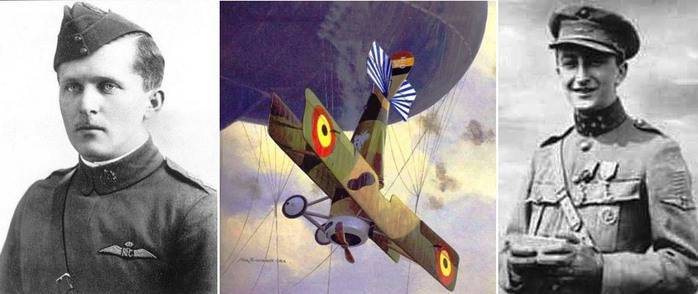
After the end of World War 1, in the history of air ramming, of course, there was a break. Again the ram, as a means of destroying the enemy aircraft, the pilots remembered during the Spanish Civil War. At the very beginning of this war - in the summer of 1936 g - the republican pilot Lieutenant Urtubi, who was in a bind, fired all the cartridges at the Franco aircraft surrounding him, rammed an Italian fighter "Fiat" from a low-angle viewpoint on the slow-moving "Newpore". Both planes crumbled from impact; Urtubi managed to open a parachute, but on the ground he died from wounds received in battle. And about a year later (in July, 1937 d) on the other side of the globe - in China - a sea ram was held for the first time in the world, with a mass ram: at the very beginning of Japan’s aggression against China, 15 Chinese pilots sacrificed themselves, having fallen from the air at enemy landing ships and sinking 7 of them!
October 25 1937 r held the world's first night air ram. It was made in Spain by the Soviet volunteer pilot Yevgeny Stepanov, who in severe conditions destroyed the Italian Savoy-Marcheti bomber with the landing gear of his Chato biplane (I-15). Moreover, Stepanov rammed the enemy, having an almost full ammunition - an experienced pilot, he understood that his small-caliber machine guns could not shoot down a huge three-engined plane from one approach, and after a long line of bomber went to ram so as not to lose the enemy in the dark. After the attack, Eugene returned safely to the airfield, and in the morning in the area indicated by him, the Republicans found fragments of Marcheti ...
22 June 1939 r over Halkhin Gol, the first ram in Japanese aviation was made by the pilot Shogo Saito. Saito, who was squeezed "in the ticks" by Soviet aircraft, who had shot all the ammunition, made a breakthrough, cutting down part of the tail of the fighter closest to him, and escaped from the encirclement. And when, a month later, 21 July, rescuing his commander, Saito tried to ram the Soviet fighter again (the ram did not work - the Soviet pilot dodged the attack), the comrades gave him the nickname “King of rams”. "The king of rams" Shogo Saito, who had 25 victories in his account, died in July 1944 in New Guinea, fighting in the ranks of the infantry (after losing the plane) against the Americans ...
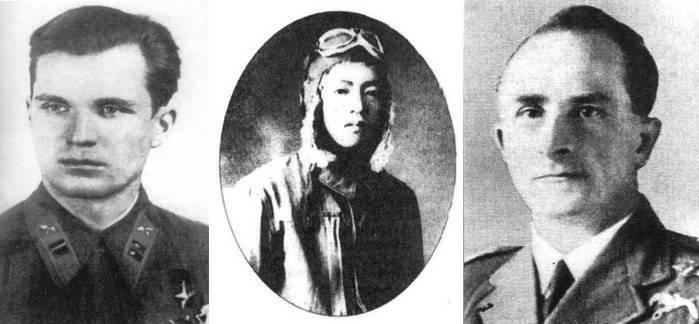
The first air ram in the 2 World War I was committed not by the Soviet, as is commonly believed in us, but by the Polish pilot. This ram produced 1 September 1939 Mr. Deputy Commander of the Interceptors Brigade covering Warsaw, Lieutenant Colonel Leopold Pamula. He shot down in a battle with the superior forces of the enemy 2 bomber, he went on his damaged plane to ram one of the 3-x fighters attacking him Messerschmitt-109. After destroying the enemy, Pamula escaped by parachute and made a safe landing in the disposition of his troops. Six months after Pamula’s exploit, another foreign pilot made an air ram: February 28 1940 r in a fierce air battle over Karelia Finnish pilot Lieutenant Hutanantti rammed a Soviet fighter and died.
Pamula and Hutanantti were not the only foreign pilots who made rams at the beginning of World War II. During the German offensive on France and Holland, the pilot of the British Battle bomber N.M. Thomas accomplished the feat that we today call the “Gastello feat.” Trying to stop the swift German offensive, the Allied command on May 2, 12 ordered the destruction of the crossings across the Meuse north of Maastricht at any cost, along which enemy tank divisions. However, German fighters and anti-aircraft guns repulsed all the attacks of the British, inflicting terrifying losses on them. And then, in a desperate desire to stop the German tanks, the flight officer Thomas sent his battled "Battle" anti-aircraft gun to one of the bridges, having managed to inform the comrades about the decision ...
Six months later, another pilot repeated the "feat of Thomas." In Africa, 4 November 1940 r another Battle bomber pilot - Lieutenant Hutchinson was hit by anti-aircraft fire during the bombing of the Italian positions in Nyalli (Kenya). And then Hutchinson sent his “Battle” into the thick of the Italian infantry, destroying enemy soldiers near 20 at the cost of his own death. Eyewitnesses claimed that at the moment of the ram Hutchinson was alive - the British bomber was controlled by the pilot until the collision with the ground ...
During the Battle of England, the British fighter pilot Ray Holmes distinguished himself. During the German raid on London 15 September 1940 r one German bomber Dornier-17 broke through the British fighter barrier to Buckingham Palace - the residence of the King of Great Britain. The German was already preparing to drop bombs on an important goal when Ray appeared on his way on his Hurricane. Having dived on top of the enemy, Holmes, on an oncoming course, chopped off the tail of Dornier with his wing, but also received such heavy damage that he was forced to flee by parachute.
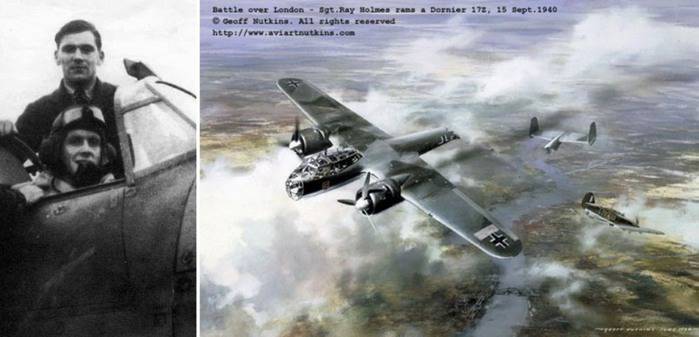
The next fighter pilots who went for the death risk victory were the Greeks Marino Mitralekses and Grigoris Valkanas. In the course of the Italian-Greek war 2 on November 1940 r over Thessaloniki Marino Mitralexes rammed an Italian bomber Kant Z-24 with his propeller PZL P-1007. After ramming, Mitralexes not only landed safely, but also managed to capture the crew of the bomber he had captured with the help of local residents! Volkanas accomplished his feat of 18 on November 1940. During a fierce group battle in the region of Morov (Albania), he shot all the bullets and went to ram an Italian fighter (both pilots died).
With the escalation of hostilities in 1941 (the attack on the USSR, the entry of Japan and the United States into war), ramming became quite common in aerial warfare. Moreover, these actions were characteristic not only of Soviet pilots - the ram was committed by pilots of almost all countries participating in the battles.
So, 22 December 1941 r fought as part of the British Air Force Australian sergeant Reed, having spent all the ammunition, rammed with his Brewster-239 the Japanese army fighter Ki-43, and was killed in a collision with him. At the end of February 1942 Mr. Dutchman J. Adam on the same Brewster also rammed a Japanese fighter, but survived.
Made the rams and pilots of the United States. Americans are very proud of their captain Colin Kelly, who in 1941 r was introduced by propagandists as the first "taraler" of the United States, who rammed the 10 of December with his B-17 bomber, the Japanese battleship Haruna. However, after the war, researchers found that Kelly did not commit any ramming. Nevertheless, the American really accomplished the feat, which, due to the pseudo-patriotic inventions of journalists, was unjustly forgotten. On that day, Kelly bombed the Nagara cruiser and distracted all the fighters of the Japanese squadron cover, providing an opportunity to calmly bomb the enemy with other aircraft. When Kelly was shot down, he tried to maintain control of the aircraft to the end, allowing the crew to leave the dead car. At the cost of his life, Kelly was saved by ten comrades, but he did not manage to escape himself ...
Based on this information, the first American pilot who actually committed the ram was Captain Fleming, commander of the Vindicedaytor bomber squadron of the United States Marine Corps. During the Battle of Midway 5 Jun 1942 g he led the attack of his squadron on the Japanese cruisers. On the approach to the goal, his plane was hit by an anti-aircraft projectile and caught fire, but the captain continued the attack and bombed. Seeing that the bombs of his subordinates did not hit the target (the squadron consisted of reservists and had poor training), Fleming turned around and again swooped on the enemy, crashing into a burning bomber on the cruiser Mikuma. The damaged ship lost its combat capability, and was soon finished off by other American bombers.
Another American who went to the ram was Major Ralph Cheli, who on August 18 1943 led his bomber group to attack the Japanese airfield Dagua (New Guinea). Almost immediately his B-25 "Mitchell" was hit; then Cheli sent his burning plane down and crashed into enemy aircraft on the ground, breaking five cars with the Mitchell hull. For this feat, Ralph Cheli was posthumously awarded the highest award of the USA - the Congressional Medal of Honor.
In the second half of the war, the British used many rambles, although perhaps in a somewhat peculiar way (but with no less risk to their own lives). German Lieutenant General Erich Schneider, when describing the use of V-1 airplanes against England, testifies: "Brave British pilots shot down projectiles either by attacking with cannon and machine guns or ramming them from the side." This way of fighting was chosen by British pilots not by accident: very often when firing a German projectile blew up, destroying the pilot who attacked him - after all, with the V-bomb, the radius of absolute destruction was about 100 meters, and to hit a small target moving with great speed from a greater distance is very difficult, almost impossible. Therefore, the British (also, of course, at the risk of dying) flew close to the Fau and pushed him to the ground with a wing kick on the wing. One wrong move, the slightest mistake in the calculation - and only a memory remained from the brave pilot ... That's exactly how the best English Fau hunter, Joseph Berry, acted, who destroyed German projectiles for 4 of the month of 59. October 2 1944 g he went on the attack on the 60 th "Fau", and this ram was his last ...
So Berry and many other British pilots rammed German Fau-1 projectiles
With the onset of raids by American bombers on Bulgaria, air ramming and Bulgarian aviators had to be made. On December 20 in the afternoon, 1943 r reflected the raid on Sofia 150 Liberator bombers, which were accompanied by 100 Lightning fighters, Lieutenant Dimitar Spisarevsky fired his entire Bf-109G-2 fighter into one of the Liberators, and a band, and a band, and then a band. , crashed into the fuselage of the second "Liberator", breaking it in half! Both planes crashed to the ground; Dimitar Spisarevsky died. The feat of Spisarevsky made him a national hero. This ram made an indelible impression on the Americans - after the death of Spisarevsky, the Americans were afraid of every approaching Bulgarian Messerschmitt ... Feat Dimitar 17 April 1944 r repeated Nedelcho Bonchev. In a fierce battle over Sofia against 350 B-17 bombers, covered by 150 fighters "Mustang", Lieutenant Nedelcho Bonchev shot down a 2 bomber from three destroyed by the Bulgarians in this battle. And the second plane Bonchev, having spent all the ammunition, rammed. At the time of the ramming strike, the Bulgarian pilot, together with the seat, was thrown out of Messerschmitt. With difficulty getting rid of the seat belts, Bonchev escaped by parachute. After Bulgaria moved to the side of the anti-fascist coalition, Nedelcho took part in the battles against Germany, but in October 1944 r was shot down and captured. During the evacuation of the concentration camp in the first days of May 1945 r, the hero was shot by a guard.
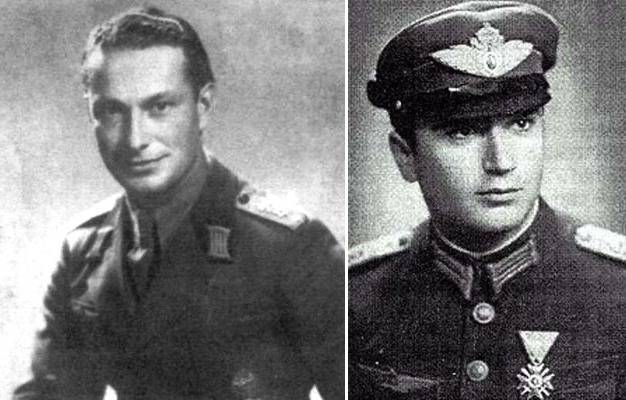
As noted above, we have heard a lot about the Japanese suicide bombers, for whom the ram was in fact the only weapons. However, it is necessary to say that the rams were carried out by Japanese pilots even before the appearance of the “kamikaze”, but then these acts were not planned and were carried out usually either in the heat of the battle, or in case of heavy damage to the aircraft, which excluded its return to the base. A striking example of the attempt of such a ram is the Japanese sea pilot Mitsuo Futida’s dramatic description in his book “The Battle of Midway Atoll” of the last attack by Lieutenant Commander Yiichi Tomonaga. The commander of the torpedo squadron of the aircraft carrier Hiryu Yoichi Tomonaga, who could well be called the predecessor of the kamikaze, 4 June 1942 r at the moment critical for the Japanese in the battle for Midway flew into battle on a heavily damaged torpedo bomber, who had one of the bak in the previous battle. At the same time Tomonaga was fully aware that he did not have enough fuel to return from the battlefield. During a torpedo attack on the enemy, Tomonaga tried to ram his flagship aircraft carrier, Yorktown, with his Kate, but, shot down by the entire artillery of the ship, fell apart into pieces just a few meters from the side ...
Attack torpedo "Kate", taken from the aircraft carrier "Yorktown" during the Battle of Midway Atoll.
Something like this was the last attack of Tomonaga (it is quite possible that it was his plane that was shot)
However, not all ramming attempts ended for the Japanese pilots as tragically. For example, 8 October 1943 r fighter pilot Satosi Anabuki on a lightweight Ki-43, armed with only two machine guns, managed to shoot down an American fighter and 2 B-3 four-engine bomber in one battle! And the third bomber spent the entire ammunition Anabuki destroyed ram attack. After this ram, the wounded Japanese managed to land his wrecked plane "on a forced one" on the coast of the Burmese Gulf. For his feat, Anabuki received an exotic for Europeans, but a reward quite familiar to the Japanese: the commander of the forces of the Burma district, General Kawabe, dedicated a poem of his own to the heroic pilot ...
A particularly “cool” “rammer” among the Japanese was 18-year-old junior lieutenant Masadziro Cavato, who flew aerial ram during his 4 combat career. The first victim of the suicide attacks of the Japanese was the B-25 bomber, which Kavato shot down Rabaul with a strike from his remaining Zero cartridges (the date of this ram is unknown to me). Paratrooper Masadziro 11 November 1943 g again rammed an American bomber, while receiving an injury. Then, in the 17 battle of December, 1943 of Mr. Kavato in a frontal attack rammed the Aerocobra fighter, and again escaped by parachute. The last time Masadziro Kavato rammed a X-NUMX February 6 of Rabeul was a four-engined Liberator B-1944 bomber, and again used his parachute to rescue. In March, 24 G seriously injured Kavato was captured by the Australians, and the war ended for him.
And less than a year before the capitulation of Japan - in October, 1944 - the “kamikaze” joined the battle. The first Kamikaze attack was carried out on 21 on October 1944 by Lieutenant Kuno, which damaged the ship Australia. And on October 25 1944, the first successful attack of the whole Kamikaze unit under the command of Lieutenant Yuki Seki took place, during which the aircraft carrier and cruiser were sunk, and the aircraft carrier 1 was damaged. But, although the main targets of the “kamikaze” were usually enemy ships, the Japanese had suicide squads and to intercept and destroy with ram attacks of the heavy American B-29 “Super Fortress” bombers. So, for example, in the 27 regiment of the 10 th division, a link of specially lightened Ki-44-2 planes under the command of Captain Matsuzaki was created, which had the poetic name "Sinten" ("Sky Shadow"). These “Sky Shadow Kamikazes” became a real nightmare for Americans who flew to bomb Japan ...
Since the end of World War 2 and to this day, historians and amateurs have argued: did the kamikaze movement make sense, was it successful enough. In official Soviet military-historical works, the 3 negative reasons for the emergence of Japanese suicide bombers were usually highlighted: the lack of modern technology and experienced personnel, fanaticism, and the “voluntary-compulsory” method of recruiting executors of a fatal departure. Fully agreeing with this, it is necessary, however, to recognize that under certain conditions this tactic brought some advantages. In that situation, when untrained pilots, hundreds and thousands, died without any sense from the crushing attacks of superbly trained American pilots, from the point of view of the Japanese command, it was undoubtedly advantageous that they would cause at least some damage to the enemy. It is impossible here not to take into account the special logic of the samurai spirit, implanted by the Japanese leadership as a model among the entire Japanese population. According to her, a warrior is born in order to die for his emperor and the “beautiful death” in battle was considered the pinnacle of his life. It was this incomprehensible logic for a European that prompted Japanese pilots at the beginning of the war to fly into battle without parachutes, but with samurai swords in the cockpits!
The advantage of suicide tactics was the fact that the range of "kamikaze" in comparison with conventional aircraft doubled (it was not necessary to save gasoline to return back). The enemy’s losses in people from suicide attacks were much greater than the losses of the kamikaze themselves; Moreover, these attacks undermined the morale of the Americans, who were so horrified by suicide bombers that the American command was forced to classify all the information about the “kamikaze” during the war in order to avoid complete demoralization of the personnel. After all, no one could feel protected from sudden attacks of suicide bombers - not even the crews of small ships. With the same gloomy stubbornness, the Japanese attacked everything that could swim. As a result, the results of the kamikaze activities were much more serious than the allied command then attempted to present (but about this - in conclusion).
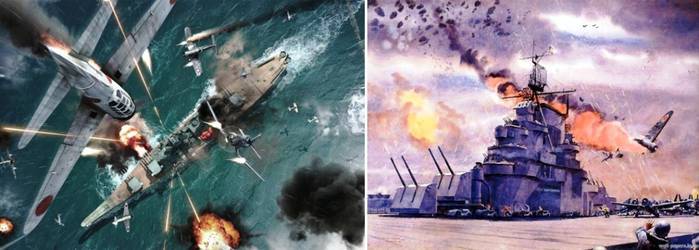
In Soviet times, in the domestic literature, not only was there never even a mention of air ramming by German pilots, but it was also repeatedly stated that it was impossible to accomplish such exploits by "cowardly fascists." And this practice continued in the new Russia right up to the middle of the 90-s, while thanks to the appearance in our country of new Western studies translated into Russian and the development of the Internet, it became impossible to deny the documented facts of the heroism of our main adversary. Today is already a proven fact: the German pilots during the years of the 2 World War I repeatedly used the ram to destroy enemy planes. But the long-term delay in the recognition of this fact by domestic researchers causes only surprise and annoyance: after all, to be convinced of this, even in Soviet times, it was enough just to look critically at least at domestic memoirs literature. In the memoirs of Soviet veteran pilots, from time to time there are references to frontal collisions over the battlefield, when the planes of the opposing sides collided with each other at counter angles. What is this if not mutual ram? And if in the initial period of the war the Germans almost did not use such a reception, then this does not speak of the lack of courage of the German pilots, but of the fact that they had at their disposal sufficiently effective weapons of traditional types that allowed them to destroy the enemy without exposing their lives to unnecessary additional risk.
I do not know all the facts of the rams committed by German pilots on different fronts of World War 2, especially since even those involved in the battles often find it difficult to say for sure whether it was a deliberate ram or an accidental clash in the confusion of high-speed maneuvering combat which recorded the rams). But even when listing the cases of ram victories of the German aces known to me, it is clear that in a hopeless situation the Germans bravely went on a deadly clash for them, often not sparing their lives for the sake of harming the enemy.
If we speak specifically about the facts known to me, then among the first German "tarasters" can be called Kurt Sohatzi, who 3 August 1941 from Kiev, reflecting the attack of the Soviet attack aircraft on the German positions, destroyed the "unstuckable Cement Bomb" IL-2 with a frontal ram attack. When Messerschmitt collided, Kurt lost half of his wing, and he had to hastily make an emergency landing right along the flight path. Sohatzi landed on Soviet territory and was captured; nevertheless, the command in absentia awarded him the highest honor of Germany - the Knight's Cross for the feat.
If at the beginning of the war the ramming actions of the German pilots who had been victorious on all fronts were rare exceptions, then in the second half of the war, when the situation was not in favor of Germany, the Germans began to use ram attacks more frequently. So, for example, 29 March 1944 g in the skies of Germany famous ace Luftwaffe Herman Graf rammed the American fighter "Mustang", while receiving severe injuries, put him on a hospital bed for two months. The next day, March 30, 1944, on the Eastern Front, repeated the "Gastello feat" of the German assault ace, Knight's Cross holder Alvin Boerst. In the area of Yass, he on the anti-tank variant Ju-87 attacked a Soviet tank column, was hit by anti-aircraft guns and, dying, rammed the tank in front of him. Posthumously, Boers was awarded with Swords to the Knight's Cross. In the West 25 in May 1944 r a young pilot Oberfenrich Hubert Heckman on Bf.109G rammed Mustang captain Joe Bennett, decapitating the American fighter squadron, and then escaped by parachute. And 13 July 1944 r another famous ace - Walter Dahl - hit by a heavy American bomber B-17.
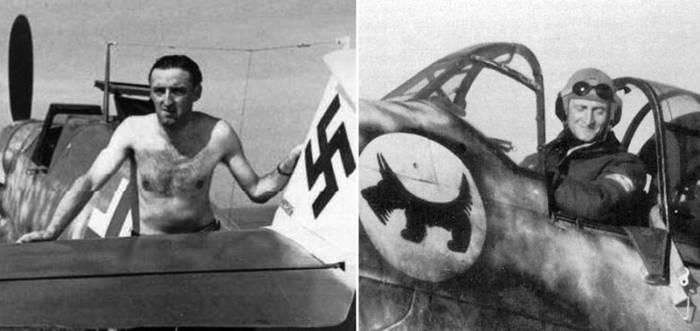
There were Germans pilots who committed several rams. For example, in the skies of Germany, when repelling American raids, Hauptmann Werner Gert rammed enemy planes three times. In addition, the pilot of the assault squadron of the Udet squadron, Willy Maksimovich, became widely known, destroying American four-engine bombers with ram attacks 7 (!). Vili died over Pillau in an air battle against Soviet 20 fighters on April 1945.
But the cases listed above are only a small part of the air ramies committed by the Germans. In the conditions of the allied aviation’s full technical and quantitative superiority over the German war over the Germans, the Germans were forced to create units of their “kamikazes” (and even before the Japanese!). Already at the beginning of 1944, the formation of special fighter-assault squadrons for the destruction of the American bombers that bombed Germany began in the Luftwaffe. The entire personnel of these units, which included volunteers and ... penalty box, gave a written commitment to destroy at least one bomber on each sortie — if necessary, by means of ram attacks! It was precisely in such a squadron that Vili Maksimovich, mentioned above, entered, and Major Walter Dahl, already familiar to us, headed these units. The Germans were forced to resort to the tactics of mass rams precisely at that period when their former air superiority was nullified by the hordes of the heavy Allied Flying Forts, which were advancing from the west, and armadas of Soviet planes attacking from the east. It is clear that the Germans did not adopt such tactics from a good life; but this does not detract from the personal heroism of the German fighter pilots who voluntarily decided on self-sacrifice to save the German population, who died under the American and British bombs ...
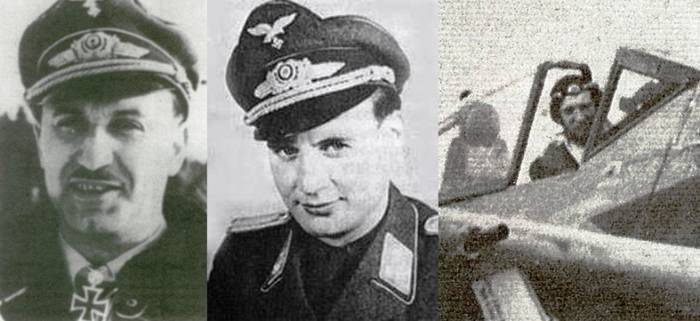
The official adoption of ramming tactics required the Germans to create the appropriate equipment. Thus, all fighter-assault squadrons were equipped with a new modification of the FW-190 fighter with enhanced armor that protected the pilot from enemy bullets at the moment of approaching closely (actually the pilot was sitting in an armored box completely covering him from head to toe). The best test pilots practiced methods of rescuing a pilot from an aircraft damaged by a ram attack with the attack aircraft “rammers” —General Adolf Galland, the commander of German fighter aircraft, believed that attack fighters should not be suicide bombers and did everything possible to save these valuable pilots ...
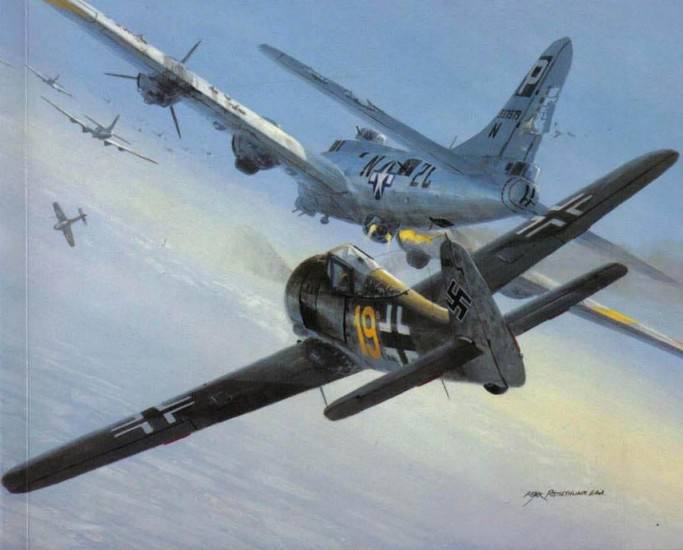
get close to the “Flying Fortresses” and produce a murderous ram
When the Germans, as allies of Japan, learned about the tactics of "kamikazes" and the high performance of units of Japanese suicide pilots, as well as the psychological effect produced by the "kamikazes" on the enemy, they decided to transfer the Eastern experience to the western lands. At the suggestion of Hitler’s favorite, the famous German test pilot Hanna Reitsch, and with the support of her husband, the observant-general of aviation, von Grimm, at the end of the war a manned shell aircraft was created for the pilot-suicide bomb ( which, however, had a chance to use the parachute over the target). These man-bombs were intended for massive strikes on London - Hitler hoped with total terror to force the UK to withdraw from the war. The Germans even created the first squad of German suicide bombers (1 volunteers) and began their training, but they did not have time to use their “kamikazes”. The inspirer of the idea and the commander of the detachment of Hana Reich came under another bombing of Berlin and landed in the hospital for a long time, and General Galland immediately dismissed the detachment, considering the idea of a mortal terror to be madness ...
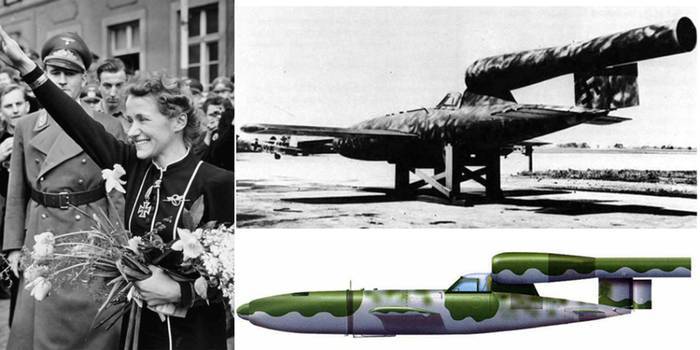
Conclusion:
So, based on the above, we can conclude that the ram, as a form of battle, was characteristic not only of Soviet pilots - the rams were made by pilots of almost all countries participating in the battles.
Another thing is that our pilots spent much more rams than the "foreigners." In total, during the war, the Soviet aviators, with the cost of killing 227 pilots and losing more than 400 airplanes, succeeded in destroying enemy aircraft in the air by ramming 635. In addition, Soviet pilots made 503 land and sea rammers, of which 286 was performed on attack aircraft with a crew of 2 man, and 119 - bombers with a crew of 3-4 man. Thus, according to the number of pilots who died during suicide attacks (no less than 1000 people!), The USSR, together with Japan, undoubtedly dominates the gloomy list of countries whose pilots widely sacrificed their lives to achieve victory over the enemy. However, it must be admitted that the Japanese still surpassed us in the sphere of the "purely Soviet form of battle." If we evaluate only the effectiveness of the “kamikaze” (1944 d operating since October), then at the price of more than 5000 Japanese pilots were sunk around 50 and damaged around 300 enemy warships, of which 3 sunk and 40 damaged were aircraft carriers with a huge number of aircraft on board .
So, in terms of the number of rams, the USSR and Japan are far ahead of the rest of the warring countries. Undoubtedly, this testifies to the courage and patriotism of the Soviet and Japanese pilots, however, in my opinion, does not detract from the same merits of the pilots of other countries involved in the war. When the situation was hopeless, not only the Russians and the Japanese, but also the British, Americans, Germans, Bulgarians, and so on. etc. went to the ram, risking their own lives for the sake of victory. But they went only in a hopeless situation; Regularly using complex expensive equipment as a banal “cleaver” is a stupid and expensive business. My opinion: the mass use of rams speaks not so much about the heroism and patriotism of a certain nation, but about the level of its military equipment and the preparedness of the flight personnel and command, constantly putting their pilots in a hopeless situation. In the air units of countries in which the command skillfully led units, creating an advantage in the forces in the right place, whose planes had high combat characteristics, and the pilots were well trained, the need to ram the enemy simply did not arise. But in the air units of countries in which the command was not able to concentrate forces on the main direction, in which the pilots could not really fly, and the planes had mediocre or even low flight characteristics, the ram became almost the main form of combat. That is why at the beginning of the war, the Germans who had the best aircraft, the best commanders and pilots did not actually use ramming. When the enemy created more sophisticated aircraft and surpassed the Germans quantitatively, and the Luftwaffe lost in the many battles of the most experienced pilots and did not have time to really train novices, the ramming method entered the arsenal of German aviation and reached the absurdity of "man-bombs" ready to fall on their heads civilians ...
In this regard, I would like to note that just at that time when the Japanese and Germans began the transition to the “kamikaze” tactics, in the Soviet Union, which also widely used air ramming, the commander of the USSR Air Force signed a very interesting order. It said: “To explain to the personnel of the Red Army air force that our fighters are superior to all existing types of German fighters in tactical flight data ... The use of a“ ram ”in air combat with enemy aircraft is not practical, therefore the“ ram ”should be used only in exceptional cases. " Leaving aside the qualities of Soviet fighters, the advantages of which over the enemy, it turned out, it was necessary to “explain” to front-line pilots, pay attention to the fact that at a time when the Japanese and German commanders tried to develop the line of using suicide bombers, the Soviet tried to stop the already existing trend Russian pilots to suicide attacks. And there was something to think about: it was only in August that 1944 d - the month preceding the appearance of the order - Soviet pilots made air ram more than in December 1941 g - during the critical period for the USSR fighting near Moscow! Even in April, the 1945 g, when Soviet aviation had absolute air supremacy, the Russian pilots used as many rams as in November 1942 g, when the offensive began at Stalingrad! And this despite the “clarified superiority” of the Soviet technology, the undoubted advantage of Russians in the number of fighters and, in general, the number of air rams that decreased from year to year (in 1941-42 - around 400 rams, in 1943-44 - around 200, rams , in 1945 g - more 20 rams). And everything is explained simply: with the keen desire to beat the enemy, the majority of young Soviet pilots simply did not really know how to fly and fight. Remember, this was well said in the film “Only old men go to battle”: “They still do not know how to fly, they also cannot shoot, but - EAGLES!”. It is for this reason that Boris Kovzan, who did not know how to turn on his onboard weapons at all, made 3 from his 4 rams. And it is for this reason that Ivan Kozhedub, an instructor of the aviation school who knew how to fly well, in 120 of the battles he conducted never rammed the enemy, even though his situations were very unprofitable. But Ivan Nikitovich coped with them without the “ax method”, because he had a high flight and combat training, and he had one of the best aircraft in the national aviation ...
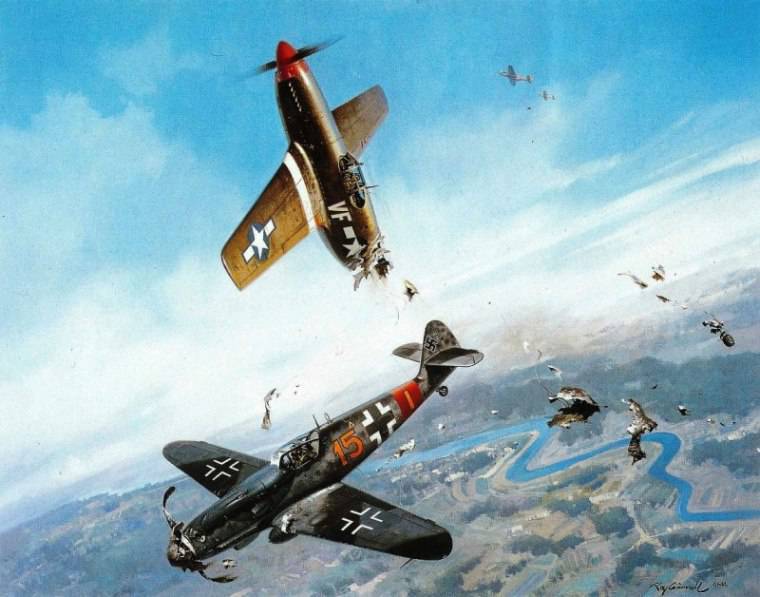
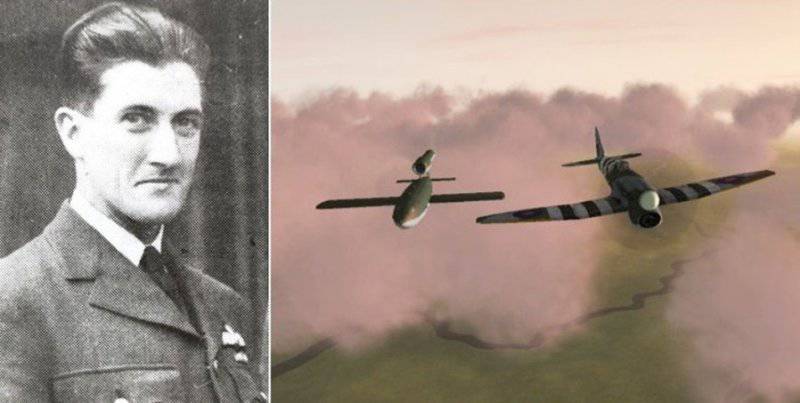
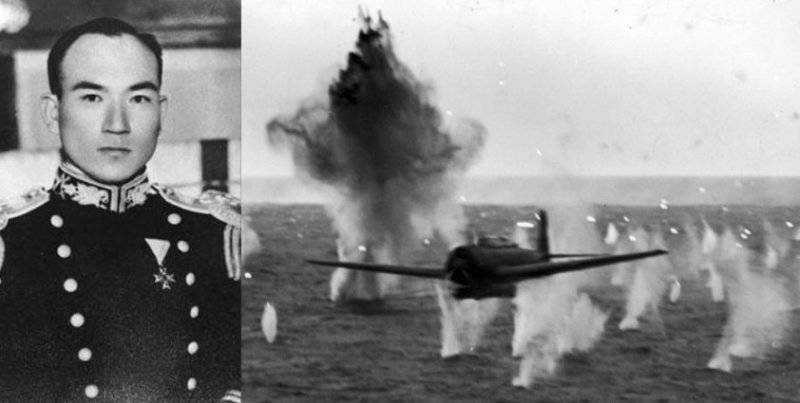
Information